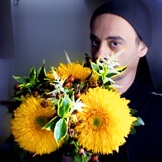WHAT
I began those past years a pictorial practice fully based and thought from what was strictly physical and material in painting. I have always been fascinated by the materiality of painting by its tactile side - its tactility and how this affinity should be able to finally transmit feelings and ideas which could be very very abstract.
My relationship to painting is not any more in term of capture of the real-world. It is the picture in itself which is reality. What is the reality ? It's the reality of the act to paint which comes to appear there. I any more will not seek something elsewhere to nourish it or to justify it.
WHERE
Traveling around the world, I placed myself by the teachings that I received from books of painting, museums, exhibitions, writings, but even more from an old master met in a lost shrine at the base of Mt. Fuji (Japan), a tribe of philosophical Bedouins at the bottom of Sinai Mount (Egypt), a child affected by land mines in a refugee camp at the Burma border (Thailand) …
And the development of the practice in this line, while on the move, or working in the studio, in front of that tradition of the abstraction not like a stylistic choice but rather like a way of placing itself with respect vis-à-vis the Real.
WHEN
My «job» as a painter is made up of moments. A series of moments of truth which represent actually the taking risk of the artist. The moment of truth is “of truth” when it irreversibly fixes something on which you cannot return: One moment that you cannot play again. If time is closed implacably with our incapacity to be able to play again, in the same time, it opens us to an infinite depth with freedom to produce the new one. Painting confirms what time affirms while making use as much of the daily life that moments of truth which are works of art. A time when nostalgia under the influence of memory leaves place and gives life to the merry assent of the incipient future.
WHY
I always thought that the abstraction appeared more close to reality, in any case reality such as we live it today who is a real fragmented and popularized through the media completion… and vis-a-vis this reality and this circulation of the images, what seems really important and strong in painting to me doesn't appear in this circulation of the images, this tactility, this physical presence which has a report as well on the scale as with the opticality of painting.
HOW
Given the powerful role of color throughout the history of abstraction, what about the need to understand how to position it now? The artist is nourished of the whole history of art and the pictures are nourished by painting which falls under a concept of historical continuity of Painting where the personal history of the artist intervenes.
---
"In art, as painting, as music, the question is not to reproduce or invent forms but to collect forces. Hence, no art is figurative. The famous statement of KLEE “not to render the visible , but to make it visible” does not mean anything else. The objective of painting is defined as an attempt to make visible things that are not.”
G. Deleuze, F. Bacon : Logic of the sensation.
---
"Art is always more abstract than we can imagine. Form and color talk about form and color, it all ends there".
Oscar Wilde.
---
Guy Matchoro, june 2018









